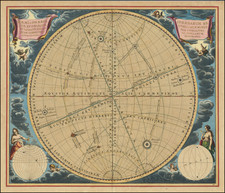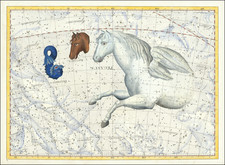Exceptional original hand-coloring and heightening in gold.
A fantastic example of this exceptionally decorative, oversized, and very rare celestial chart, produced by Frederik de Wit in Amsterdam, circa 1680. The map depicts the two celestial hemispheres surrounded by six supplementary models of the Universe and Solar System, each illustrating the Copernican hypothesis, the Ptolemaic hypothesis, the Tycho Brahe hypothesis, the phases of the moon relative to the Sun, the rotational pattern of the day, and the rotation pattern of the Moon around the Earth.
Each major celestial hemisphere is centered on the ecliptic pole and rendered on a polar stereographic projection with an external orientation. The constellations are drawn and colored to emphasize the signs of the Zodiac and other famous constellations.
De Wit's illustration of the constellations is clearly derived from the celestial hemispheres appearing as supplementary material on Joan Blaeu's 1658 wall map of the world (Shirley 371).
States & Rarity
This is the first of two states. The later state bears the imprint of Covens & Mortier.
CLC locates 3 institutional examples of the map.
A Note on Color
The coloring of this celestial chart was done by one of the best Dutch studio colorists of the 17th century, who was capable of artistry far beyond what the typical publisher colorists could accomplish at that time.
The triumphs of the hand-coloring extend beyond the careful attention to the contrast of the clouds and their subtle and moody background, to the shading of the constellations, the extensive highlighting in gold, and most importantly, the additional hand-drawn elaborate zodiac border around the central hemispheres. The elemental illustrations in this border completely reinvent the image and elevate this beyond any other celestial chart we have seen.
The grisaille painting of the central celestial hemispheres may seem understated at first, but this is actually a wonderfully successful and creative rendering of the night sky in a true-to-life manner; the constellations float out of the formless darkness, punctuated with brilliant flashes of gold, and in stark contrast with the daytime sky surrounding them.
While we have handled many beautiful celestial charts in the past, and have seen a few in the trade with exquisite hand-coloring, none has had that key border embellishment, which we take to be indicative of the highest level of late-17th-century Dutch hand-coloring. With its red-and-yellow border, careful gold highlighting, and astoundingly detailed hand-coloring, this may well be the work of Dirk Janszoon Van Santen, the most famous of the Golden Age Dutch colorists.
In addition to this De Wit chart, we recently acquired a series of Cellarius celestials from a different source, which, coincidentally, exemplify the work of the same master colorist that can be seen here. See, for instance, this pair of pagan celestial hemispheres by Cellarius: www.raremaps.com/gallery/detail/81867/the-northern-and-southern-pagan-constellations-haemisph-cellarius
De Wit (1629 ca.-1706) was a mapmaker and mapseller who was born in Gouda but who worked and died in Amsterdam. He moved to the city in 1648, where he opened a printing operation under the name of The Three Crabs; later, he changed the name of his shop to The White Chart. From the 1660s onward, he published atlases with a variety of maps; he is best known for these atlases and his Dutch town maps. After Frederik’s death in 1706, his wife Maria ran the shop for four years before selling it. Their son, Franciscus, was a stockfish merchant and had no interest in the map shop. At the auction to liquidate the de Wit stock, most of the plates went to Pieter Mortier, whose firm eventually became Covens & Mortier, one of the biggest cartography houses of the eighteenth century.










![Ursa minor [The Little Dipper and Polaris]](https://storage.googleapis.com/raremaps/img/small/74396.jpg)
![Idea dell' universo [Two-Sheet Cosmographical Chart]](https://storage.googleapis.com/raremaps/img/small/90009.jpg)
![[The July, August & September Sky -- Sagittarius, Scorpio, Libra, Capricorn, Hercules, Corona Boralis, Serpentrarius, Delphius, Aquila, Lepus , etc.]](https://storage.googleapis.com/raremaps/img/small/87078.jpg)

![[Hydra]](https://storage.googleapis.com/raremaps/img/small/67628.jpg)